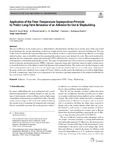Application of the Time–Temperature Superposition Principle to Predict Long-Term Behaviour of an Adhesive for Use in Shipbuilding

Use este enlace para citar
http://hdl.handle.net/2183/37767
Excepto si se señala otra cosa, la licencia del ítem se describe como Attribution 4.0 International
https://creativecommons.org/licenses/by/4.0/
Colecciones
- Investigación (EPEF) [590]
Metadatos
Mostrar el registro completo del ítemTítulo
Application of the Time–Temperature Superposition Principle to Predict Long-Term Behaviour of an Adhesive for Use in ShipbuildingAutor(es)
Fecha
2024-02Cita bibliográfica
Souto-Silvar, D.A., Álvarez-García, A., Díaz-Díaz, A. et al. Application of the Time–Temperature Superposition Principle to Predict Long-Term Behaviour of an Adhesive for Use in Shipbuilding. Arab J Sci Eng 49, 2345–2355 (2024). https://doi.org/10.1007/s13369-023-08219-4
Resumen
[Abstract]: The use of adhesives in the marine sector is rather limited at the time being, but their use in specific areas of the ship would
be an advantage due, among other things, to their low weight and low stress concentration along the bonding joint. The aim
of this work is to predict the long-term behaviour of the material, as this is a critical factor when using adhesive as a bonding
method in ships, since its durability must be guaranteed throughout a previously defined life cycle. This can be predicted by
applying the time–temperature superposition principle (TTS), which involves carrying out a test at different temperatures for
each specimen, considerably reducing the test time. Two types of experiments have been carried out according with operation
modes in dynamic mechanical analysis (DMA): a dynamic frequency sweep and a stationary creep test under constant stress,
to check the behaviour of the adhesive under both dynamic and sustained loading. The master curve for the frequency study
will be constructed in such a way as to cover the whole range of relevant vibrations that can occur on the vessel, while that for
the creep test the curve obtained covers a range of 25 years, which is usually used as the minimum service life in shipbuilding.
For both, a temperature range from room temperature to the maximum operating temperature of the material established by
the manufacturer shall be studied.
Palabras clave
Adhesive
Viscoelastic
Time temperature superposition (TTS)
Creep
Shipbuilding
Viscoelastic
Time temperature superposition (TTS)
Creep
Shipbuilding
Descripción
Financiado para publicación en acceso aberto: Universidade da Coruña/CISUG
Versión del editor
Derechos
Attribution 4.0 International
https://creativecommons.org/licenses/by/4.0/
ISSN
2191-4281
2193-567X
2193-567X






